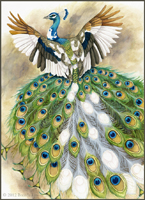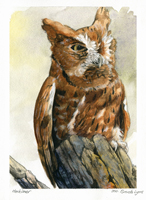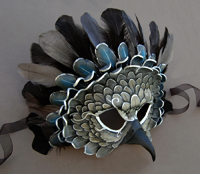For the past year, I have been painting with this paper, and recently (after going through the rest of my 15X20 pad during a massive project), purchased another pad. The pad was identical in markings, appearance and labeling, so naturally I assumed it was the same exact paper. I transferred my drawing to the paper, and after a few washes discovered it was not acting anything like my beloved Montval paper from before. In fact, previous washes were coming up. The surface was closer to a rough-press than a cold-press. Washes seemed blotchy and rough, and the colors were not blending as they used to. I was distraught! I had already started three paintings with this paper and was on a tight deadline - I could not restart them. I tried to work with the paper as best I could, but the quality was lacking.
The purpose of this post isn't to call out a particular paper manufacturer (though I am quite steamed at this company for selling me what turned out to be, essentially, a bait-and-switch in terms of quality). It is to ask - or rather plead - with watercolor paper manufacturers to not switch their sizing without warning the consumers. In what way could they do this? A simple change in labeling on the cover of the pad or block of paper would suffice. Something as simple as "new sizing from our 2012 paper" would help artists immensely. We would know to test the paper first before leaping right into extensive projects that are a terrible waste of time and money if the paper ends up not performing as expected. For watercolor artists, we rely on our paper to act the same, each time, every time. We purchase specific paper because we know exactly how our techniques will meld with that paper. When the paper doesn't perform as expected, that hurts the artist.
Here is a simple test I did to show how three different watercolor papers performed with what I call the "tree bark test". Each paper is labeled - I used the new pad of Canson Montval Paper (140 lbs, cold-press), a pad of 'student grade' Canson XL Pad Watercolor Paper (140 lbs, cold-press), and Fabriano Artistico Watercolor Paper (140 lbs, hot-press).
Step 1:
The first step is using a concentrated mixture of Indigo and Sepia watercolor with a #2 round to paint in bark details. The paint is thick in places, so I of course expect a little lifting and bleeding when I put the next layer down. I let this layer dry completely before the next step
Step 2:
With a #6 round and a light wash of Raw Umber and Colbalt Blue, I painted over each branch. Here is where you can see the catastrophic failure of the Montval paper. Although the first layer was completely dry, a simple, gentle wash brought up most of the paint beneath, creating a muddy, dark mess. Even the 'student grade' Canson XL paper performs better, and the Fabriano performs best with minimal bleeding.
This is not an isolated problem. Other watercolor artists have experienced sudden changes in watercolor paper sizing, resulting in problems with their paintings. Of course art supply companies should be free to change their product to create improved products for their customers, but it seems these sizing changes are resulting in a decrease of quality of the paper. This is unacceptable, and for those of us who make a living by painting, we need to have a steady, quality product. We cannot spend time and money guessing which paper will work and which will result in a muddy, awful mess.
In closing, I have two requests for watercolor paper manufacturers. The first is this: if you must change the sizing on your papers, please make it known on your labeling so your customers can be prepared and test the paper appropriately. Otherwise, you are harming your consumers and we will leave your product for a different one. The second request is not to change the sizing in your paper unless it has been thoroughly tested as a positive change. If it is becoming too costly to produce paper with the original quality, it is better to raise the price of your paper than to lower the quality. I, and many artists, would much rather pay more for the same quality paper we have come to rely on, than to pay the same as before for an unusuable product.
And this product is, in a word, unusuable.













This is why I've ended up falling in love with Arches. Wow does it cost a pretty penny, but I ALWAYS know how the paper is going to turn out. I also like the smoothness of the blue XL pad, but for texture definitely the arches paper. I've never had much luck with the montval line-- I used to use it in highschool, when they changed it to probably whatever you're using now, and I'm glad I didn't just choose to adjust if it's once again changed. Good luck on your paper search!
ReplyDeleteI used to use Arches but my painting style doesn't mesh well with it. I also find their hot-press to be too 'slick' and it doesn't absorb the paint well, but it's not a 'bad' paper, just not good for me :) I think for now I will be going back to Fabriano.
DeleteAs a previous store manager of two fine art retail stores, I am completely shocked that the Montval paper from Canson has deteriorated so much in quality from the time you purchased your first pad. I know that Canson had undergone many changes to its cover designs, but I had no indication whatsoever that they were changing the grade/quality of any of their papers. I'm completely appalled at the awful mess you were left to deal with - even the student grade turned out remarkably better! I'm very surprised.
ReplyDeletePerhaps you could call Canson and request that they send you a new pad to replace the one you had problems with. There is a slim chance that perhaps they goofed on the sizing in the batch you purchased, and will replace your block. It couldn't hurt to try. At least then you'd be able to know if the Montval is to blame, or if it was a mistake by Canson.
Stick with the Fabriano! (I know, it's more expensive, but good quality and time-tested).
I'm glad to hear from someone who has managed art stores on this subject! Canson has always produced very good paper - I've used their watercolor paper only recently, but their Mi-Teintes papers were always the best when it came to colored papers.
DeleteI suppose the reason why I'm so upset about this is because when I paint, I put a lot more than just time and effort into the painting. I put a lot of my energy and emotion into it, and when I can't express what I'm trying to show because of a flaw with the materials, it's more than just frustrating. I feel like I've been stung by Canson and now I'm shy to give them a second chance. I know logically I should, and I likely will ask the store where I bought the pad if I can exchange it for another one.
But what about in the future? Even if I get a 'good' pad this time, I'll always be wondering if the next pad I buy will be a 'bad' one. My confidence in their product is damaged now.
Personally I have been using the Canson brand for many years now. I too have found their quality to surpass others such as Strathmore, and I have got myself into little grooves where I don't want to use any other surface. My personal favorite is Plate Bristol... I don't know where I'd turn if the grains of that paper started to betray me.
DeleteI understand how upset you are over the sizing, and like I said I'm very surprised. Chances are good that if the retail store you purchased the pad from DOES exchange it for another pad, your replacement will have been from the same shipment (assuming you have recently purchased the new block). Still might want to pester Canson about that... either way, best of luck.
I wish I was still at my store in Boston, I'd definitely hook you up! We had tons of the old Montval pads. I loved them, but it was never a school-list item and didn't sell as quickly.
That is a worry I have - that if it WAS a bad batch, the replacement pad I get will be from the same batch. There's another art store nearby that sells them, so I may ask the original store about this issue and ask if they would suggest I just get a refund and purchase another pad from the other store. Both stores are very friendly with each other and regularly send customers to each other, so it wouldn't cause a conflict. Thanks for the suggestion!
DeleteIf the staff at both stores are willing to share customers, chances are good that the management at both retailers are pretty level headed.
DeleteGood luck with your endeavors! Hopefully you will find a suitable solution to the problem, and with any hope, the defective Montval pad will have been a fluke. :)
By the way,
DeleteAfter this discussion, I decided to rummage through a few art pads that I took with me when I left my store in Boston, and one of them is a 9x12 pad of 140lb cold press Montval. Get in touch with me if you'd like to have it. ;)
Ooh, I'd love it, actually :) My email is mysticfalcon13@hotmail.com if you want to contact me there.
DeleteWell written lady. Sizing is such an incredibly important facet of our art, and to have it go wrong... well, its pretty terrible.
ReplyDelete